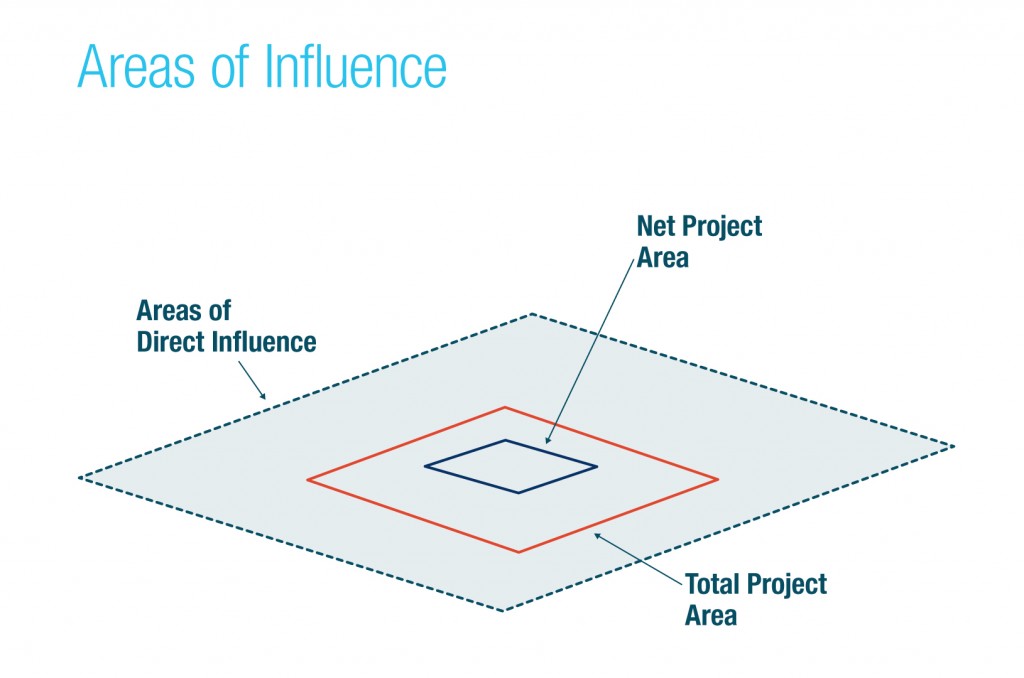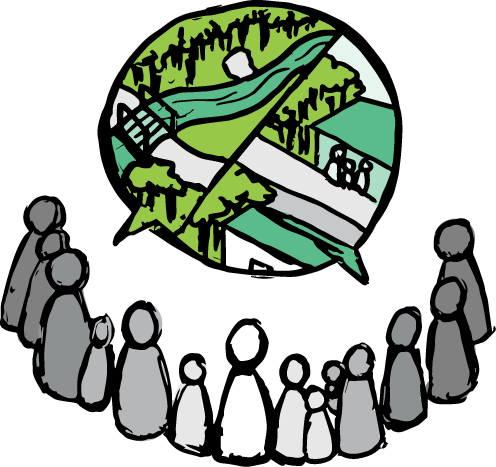In this section you will learn how to specify and narrow down the focus of the EIA, define the project area, alternatives and baseline data.
What is scoping?
Scoping is a critical step in the preparation of an EIA, as it identifies the issues that are likely to be of most importance during the EIA and eliminates those that are of little concern.
Scoping is a critical step in the preparation of an EIA, as it identifies the issues that are likely to be of most importance during the EIA and eliminates those that are of little concern. Scoping is a systematic exercise that establishes the boundaries of your EIA and sets the basis of the analyses you will conduct at each stage. A quality scoping study reduces the risk of including inappropriate components or excluding components that should be addressed. It involves:
- Identifying all relevant issues and factors, including cumulative effects, social impacts, and health risks.
- Facilitating meaningful public engagement and review.
- Determining the appropriate time and space boundaries of the EIA.
- Identifying the important issues to be considered in the EIA, such as setting the baseline and identifying alternatives.
Why conduct a scoping?
Scoping is critical as it sets up the boundaries of the EIA, including the project area; it establishes what the EIA will include and how to put the EIA together in accordance with the terms of reference (TOR).
Scoping is critical as it sets up the boundaries of the EIA, including the project area; it establishes what the EIA will include and how to put the EIA together in accordance with the terms of reference (TOR). An EIA is an intensive process in terms of costs, cross-sectoral expertise and assessments that must be completed, and the types and extent of the consultations that must be conducted. Scoping helps to select what is needed and what is not relevant, and thus it serves as a work plan for the entire EIA process. The information gathered during the scoping phase is used in the next steps of the EIA.
What approaches exist?
ExamplesCentral AmericaNational legislation usually specifies scoping procedures, listing the key sectors that need to be considered, providing guidance on public consultation and outlining the Terms of Reference (TOR).
National legislation usually specifies scoping procedures, listing the key sectors that need to be considered, providing guidance on public consultation and outlining the Terms of Reference (TOR). The main approaches to scoping found in the reviewed Central American countries include:
Public consultation and participation
This is a critical part of the EIA, and in some Central American countries it is mandated by legislation. The key groups involved in the consultations include project-affected people, host communities and local NGOs, as appropriate. It is critical to provide these stakeholder groups with opportunities to participate in the planning, implementation, and monitoring of the planned project/investment.
– See more on public consultation and participation here.
Determining the key aspects and criteria for evaluating the significance of environmental and socioeconomic impacts. This includes creating a list of environmental, biological and socioeconomic resources and issues that are important to consider, such as water, soil and land use, biodiversity and people’s access to water, land and food and energy. At this stage it is also important to identify the criteria on which impacts will be assessed, such as the amount of water extracted, waste produced, agricultural land lost and forest cover cut/replanted. The selected environmental and social resources and issues and the set of criteria will then be analyzed in detail in the next phases.
Selecting an appropriate baseline. Baseline surveys and investigations should be carried out on the issues that have significant environmental effects order to:
- Provide an understanding of existing conditions linked to a specific year e.g., base year or period.
- Decide about a timeline that will allow for predictions of how the project may change the key environmental component e.g., number of years of project operations.
- Allow for predictions of how adverse effects can be mitigated and beneficial effects enhanced e.g., years needed until the mitigation responses are implemented and start making impacts.
- Provide a sound basis for the design and evaluation of post-EIA studies e.g., early monitoring.
“Baseline data should provide a statistically valid measure of the parameter’s natural variability during the pre-project period in order to be of value for impact prediction and environmental monitoring” of the project’s impacts. (Government of Saskatchewan, 2007, n.p.) Similarly, methods for the collection of baseline and monitoring data on particular issues should be consistent—thus it is important to review the baseline data when designing the monitoring plan during the last stage of the EIA. Finally, the use of existing information is encouraged, although there will often be a need to collect additional data for certain parameters such population, vegetation details, human health data, and data on livelihood conditions in the local communities. Information should be presented in a simple and understandable form so the connection of the project impacts (both positive and negative) can be identified. This will be also important in the next phases when the EIA is evaluated.
Terms of Reference
In concluding the scoping process, the preparation of Terms of Reference (TOR) for an EIA is an important task. Alternatively, or as a supplement to TOR, a formal scoping report may be issued (especially useful if the issues and/or process are controversial). In some EIA systems, project proponents prepare their own TORs guided by legislation; in other countries the TOR is prescribed in the legislation.
– See some comprehensive examples of TORs here.
Central AmericaOverview of scoping in selected Central American countries
| Scoping (Y/N) | Consultation (Y/N) | Scoping | |
|---|---|---|---|
| Belize | Y | Y | Scoping required. Requires consultation, meetings with the government and other agencies. Scoping includes identification and analysis of impacts on human beings, flora and fauna, soil, water, air, cultural heritage, landscape, and other environmental factors; it also includes analysis of alternatives. |
| Costa Rica | N | N | Agency defines scope in TORs for the EIA. |
| Dominican Republic | N | N | No formal scoping procedure. Scope determined by government agency and includes impacts on natural resources, environmental quality, health, and on other factors. |
| Ecuador | N | N | No scoping procedure. Proponents submit draft TORs to ministry or EIA. For Category III projects, the ministry has guidelines for TORs on its web site. |
| El Salvador | N | N | Potential impacts and risks during construction, operation, and closure on the environment’s and population’s physical, biological, socioeconomic, and cultural resources are expected to narrow down during the scoping |
| Guatemala | N | N/A | The Minister responsible for planning may make regulations that specify details related to the content, criteria, and procedures for public participation and review. |
| Honduras | Y | Y | Proponent publishes information about the project in print media and the public, and NGOs have 15 days to submit comments to MiAmbiente. DECA decides which comments need to be included in the TORs. |
| Mexico | N | Consideration of ecosystems, their preservation and restoration, and protection of the environment must be narrowed down during scoping | |
| Nicaragua | N | N/A | Includes activities that can damage the environment or natural resources, or that can have negative socioeconomic, cultural, biotic, abiotic, or aesthetic impacts |
| Panama | Y | Y | Plan for citizen participation (meetings, surveys) and respond to inquiries about project components from those who would be affected. |
Source: Tiffer-Sotomayor et al., 2015
How is a scoping process conducted?
A project scoping activity can be carried out in nine main steps.
A project scoping activity can be carried out in nine main steps. These are:
- Set up the team of experts that will conduct the EIA.
- Describe the project area and the area of project influence.
- Outline project alternatives for preparation, implementation and closure.
- Conduct public meetings and stakeholder consultations; integrate comments and collected feedback into project planning and the alternatives.
- Outline a set of environmental, biological and socioeconomic resources and issues that will be addressed in the assessment.
- Define a set of criteria to assess the planned project/development.
- Identify the project impacts, during its all stages, list the significant and non-significant impacts and explain why.
- Identify a set of data for baseline descriptions and potential additional data collection needs.
- Start inserting this information in the appropriate section of the TOR.
In Honduras, it is suggested that a multidisciplinary team prepare the EIA. It is important that the multidisciplinary team is well-coordinated so that the results of environmental studies become more integrated into the design and operational plan as well as the execution of the activity, work or project. The multidisciplinary team should have a professional technical coordinator, who will be responsible for overseeing the actions and tasks. The rest of the team should be selected according to the competencies needed to comply with the requirements of the EIA. The core parts of the scoping process in Honduras are:
- Project Location: Municipality and department; location on map of the project area reference from the main paved road and nearest geolocation.
- Project area, construction area and area of influence: The area of construction is the number of square metres to be developed. The area of the land on which the project corresponds is called the “net project area,” which is part of the “total project area.” The total project area is likely to be affected by impacts generated by the project e.g., during construction by the negative environmental impacts (such as noise, emissions, vibrations, visual effects, etc.). The “area of influence” is defined as the project environment that located outside the area of the overall project and extends from its boundaries to a distance of 500 metres. This area should be included in the environmental analysis and maps should be made for the EIA. The “area of indirect influence” corresponds to the area outside the direct influence yet where the effects of the activity, work or project are detectable. Its extent depends on the specific environmental effects, and thus in turn the environmental and social impacts of the project.

- Applicable legal considerations and environmental regulations: In order to determine its legal feasibility, a project must be considered in the compliance with all legal provisions applicable to the project’s local, national, and/or regional area. It is important to identify and collect the legislation and regulations so they can be used during the scoping phase.
- Description Environmental Physical Environment: Description of the relief and topography of the site where the project will be implemented. This includes the pattern of natural surface drainage, soil type, class capacity and land use, geological situation of the land to be developed and its geomorphological situation. Determination if there is an aquifer under the area, and if there is vulnerability to natural hazards and threats, such as landslides, faults, floods, volcanic eruptions, among others. Supporting information is provided with maps, profiles and other figures.
- Biological Environment Environmental Description: Description of the existing plant cover that will be affected for project implementation, including a tree inventory and description of species and indication whether any are found on lists of endangered species.
- Description of Socioeconomic environment: Description of the characteristics of the population in the project area according to the baseline statistical data. Description of the public services available in the area of influence (Water, roads, electricity, telecommunications, education, health, emergencies). Summary of existing archaeological data for the project area.
- Summary of a consultation: Outcomes of public consultations in the vicinity of the project areas to get affected stakeholders’ opinions and feedback on project activities.
- Overview of the alternatives. Overview of the alternatives considered in the project and their major characteristics, differences and why they were chosen.
